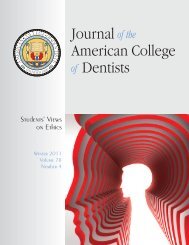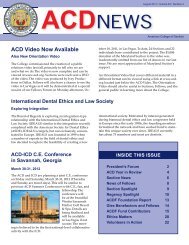JACD 71-4 - American College of Dentists
JACD 71-4 - American College of Dentists
JACD 71-4 - American College of Dentists
- No tags were found...
Create successful ePaper yourself
Turn your PDF publications into a flip-book with our unique Google optimized e-Paper software.
hour after he got the gift, I received an<br />
e-mail that is framed in my room. It’s a<br />
grazie. Now he wasn’t leaving anything<br />
to chance and leaders never do.<br />
Art Dugoni is the inventor <strong>of</strong> the<br />
loyalty cycle. How does it work? Dr.<br />
Dugoni is loyal to the dental school. When<br />
you spend your whole life somewhere,<br />
that is how you define loyalty. And that<br />
doesn’t go unnoticed. The faculty sees<br />
that the leader commits to the school, so<br />
they commit to the school. Surprise, the<br />
students are loyal to the dental school<br />
like no other students are, and those <strong>of</strong><br />
us who have been in education know<br />
that it is very difficult to get loyal alumni.<br />
I went to a Pacific event once when<br />
students were coming back after two<br />
years. You talked today about the Italian<br />
dinner—I thought it was an Italian<br />
wedding. The students were coming up<br />
and putting envelopes in his pocket.<br />
Some Unresolved Issues Facing<br />
Dentistry<br />
“Back to the Future” is the third movie.<br />
After all, what does a leader do? A leader<br />
looks at things that everyone looks at,<br />
but he sees something different and<br />
creates an opportunity.<br />
Amazing as he is, Art has not solved<br />
all <strong>of</strong> the problems facing dentistry or<br />
dental education. As I begin to call your<br />
attention to some <strong>of</strong> the more pressing<br />
<strong>of</strong> these problems, I wonder where the<br />
next generation <strong>of</strong> Art Dugoni’s is.<br />
Caries Is Back<br />
It may not sound very exciting or very<br />
much like the future, but we had better<br />
begin to pay serious attention to dental<br />
caries. A year and a half ago, I saw a<br />
picture in ADA News <strong>of</strong> migrant workers<br />
being helped by Dr. Guillermo Vicuña in<br />
Stockton, California. I enlarged the picture<br />
to the best <strong>of</strong> my ability, and saw rampant<br />
Journal <strong>of</strong> the <strong>American</strong> <strong>College</strong> <strong>of</strong> <strong>Dentists</strong><br />
caries. Yesterday, I returned to Stockton.<br />
I went through that migrant camp and<br />
looked at that caries. It’s there.<br />
I am learning <strong>of</strong> the same problem<br />
in China, Puerto Rico, New Delhi, India,<br />
Hawaii, Eastern Europe, and Africa.<br />
Remember when we were looking at<br />
Scandinavia as a role model in dentistry?<br />
I tell you I was there two weeks ago and<br />
they have caries there, too.<br />
In their 1993 textbook, Larry Tyback<br />
and Phil Bowen report, “The caries<br />
reductions may well have ceased. New<br />
clinical data indicates a 27% DMFT<br />
increased in a 10% caries-free decrease.”<br />
The second International Conference on<br />
Declining Caries noted wide discrepancies<br />
between different regions <strong>of</strong> the country<br />
and a noticeable worsening in the<br />
caries experience <strong>of</strong> children in lower<br />
socioeconomic groups. The World<br />
Health Report said that in industrialized<br />
countries, over 50% <strong>of</strong> children have<br />
dental cavities, <strong>of</strong> which 20% are in the<br />
high risk group having more than five<br />
infected teeth. How about the Surgeon<br />
General’s Report? It notes there are<br />
striking disparities in dental disease by<br />
income. Poor children suffer twice as<br />
many caries as their more affluent peers,<br />
and their disease is more likely to be<br />
untreated. The ADA, in their Future <strong>of</strong><br />
Dentistry Report, draws our attention in<br />
the same direction. “Poor people continue<br />
to experience more caries than non-poor<br />
people and are less likely to receive<br />
treatment. By age seventeen, only 16%<br />
<strong>of</strong> children are caries free and have<br />
permanent dental issues.”<br />
I have come to the conclusion that<br />
dental caries has returned. The leadership<br />
message is right in front <strong>of</strong> us and<br />
the real leaders find it and then they<br />
create opportunities. What are the other<br />
underlying factors causing this?<br />
Demographics certainly play a role. The<br />
population <strong>of</strong> America increased threefold<br />
over the last thirty to forty years.<br />
National Leadership Symposium<br />
It may not sound very<br />
exciting or very much like<br />
the future, but we had<br />
better begin to pay serious<br />
attention to dental caries.<br />
And much <strong>of</strong> this increase is related to<br />
immigration. In the changing culture,<br />
life, and community, new dental disease<br />
patterns are emerging in new contexts.<br />
I believe the current global oral<br />
health database, and the satisfaction we<br />
justifiably derived from it at one time, is<br />
rapidly becoming obsolete. So I make<br />
that first leadership proposal: For the ADA<br />
to have a leadership conference, a global<br />
oral health data summons. Bring in the<br />
World Health Organization, NIDCR, the<br />
public health people, the researchers, and<br />
FDI. Let’s meet in Chicago under the ADA<br />
Foundation banner. Let’s set the guidelines<br />
for how the world should collect<br />
this data. They are not going to do it by<br />
themselves. This is an opportunity for<br />
the Foundation and ADA to lead.<br />
Dental Insurance<br />
Second leadership challenge: the emergence<br />
<strong>of</strong> a new middle class that for the<br />
first time in world history enjoys less <strong>of</strong><br />
the benefits <strong>of</strong> life than their parents did.<br />
This new middle class is unable to afford<br />
health insurance. The New York Times<br />
reports that in 2004: “Eighty-two million<br />
27





